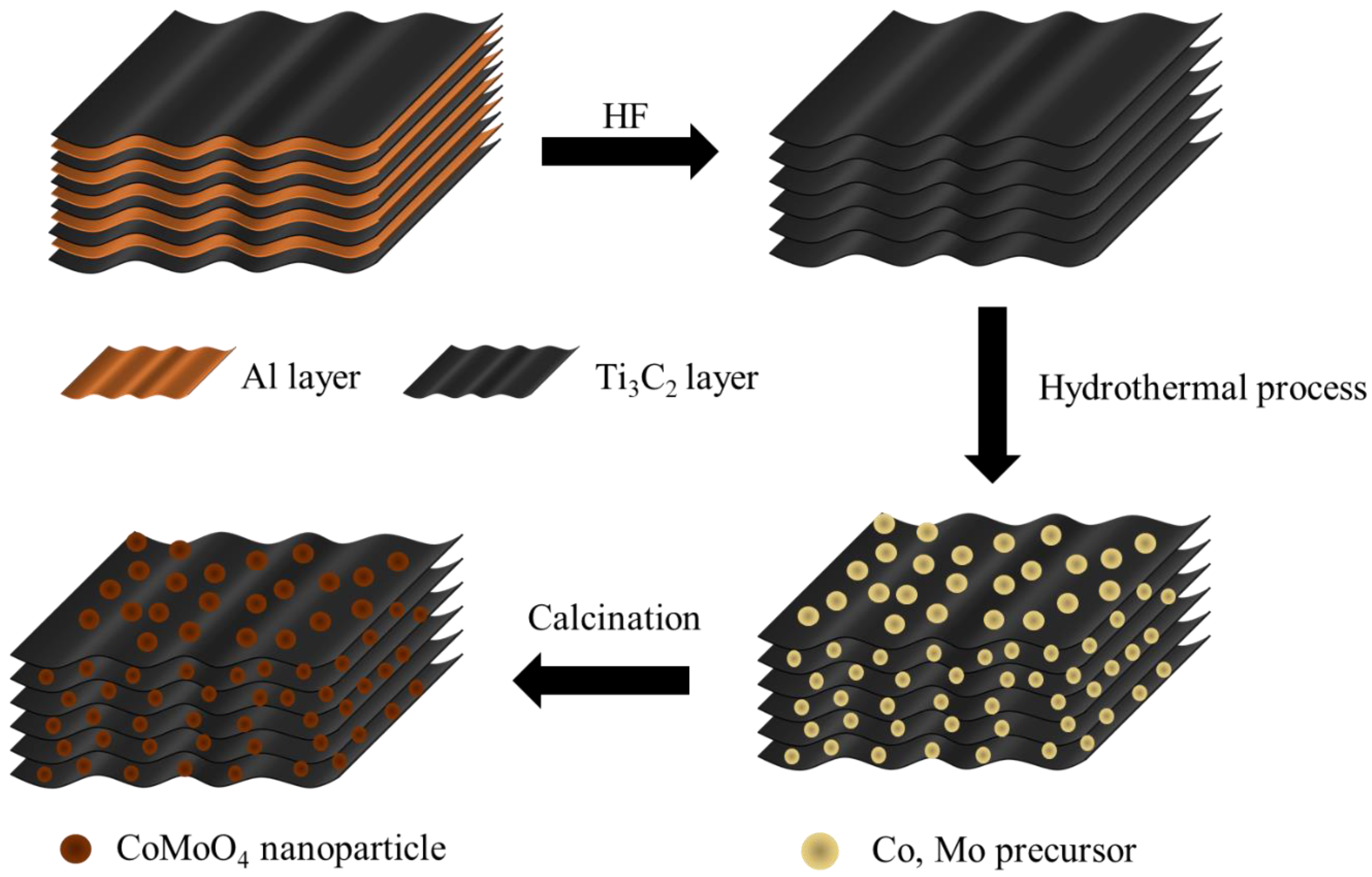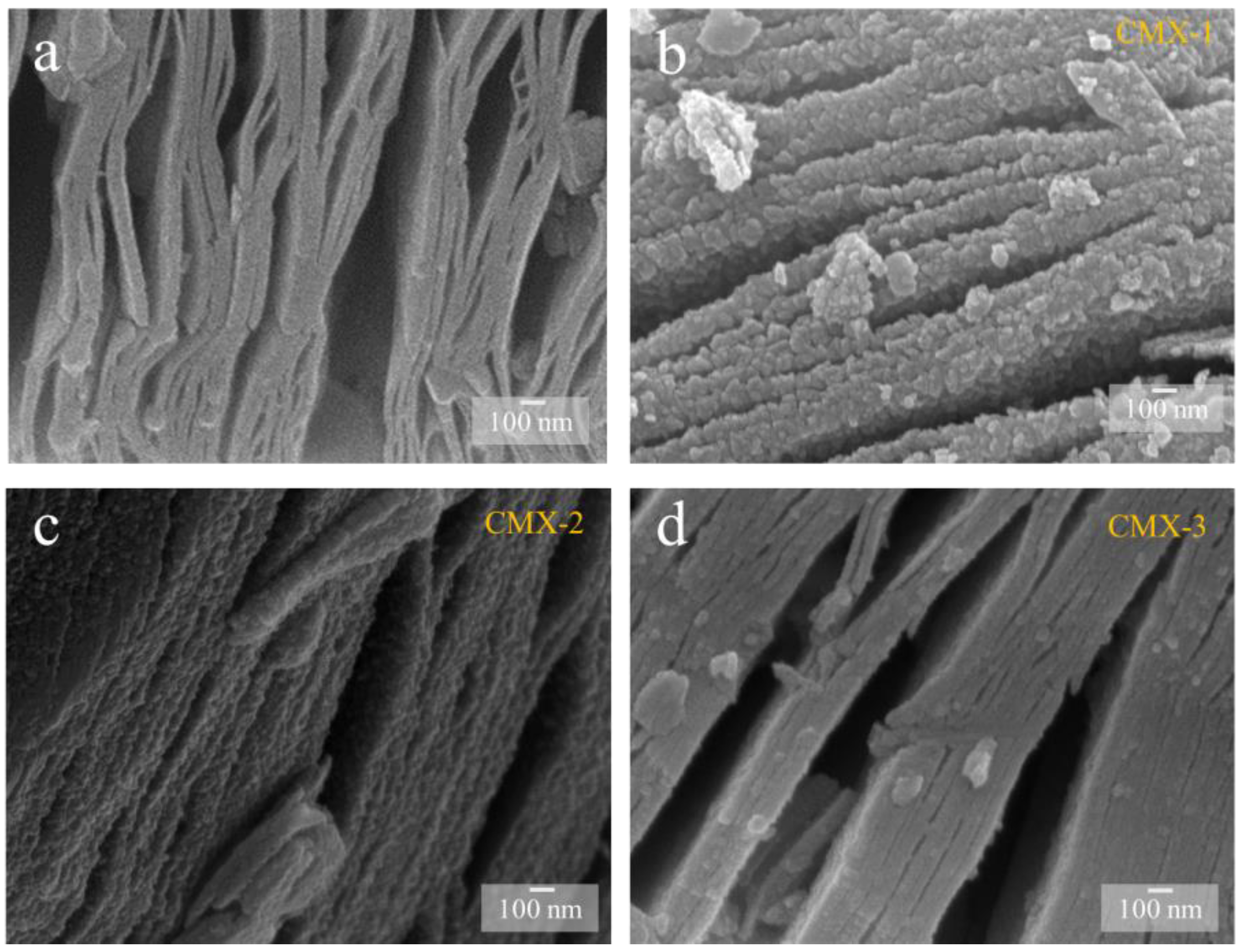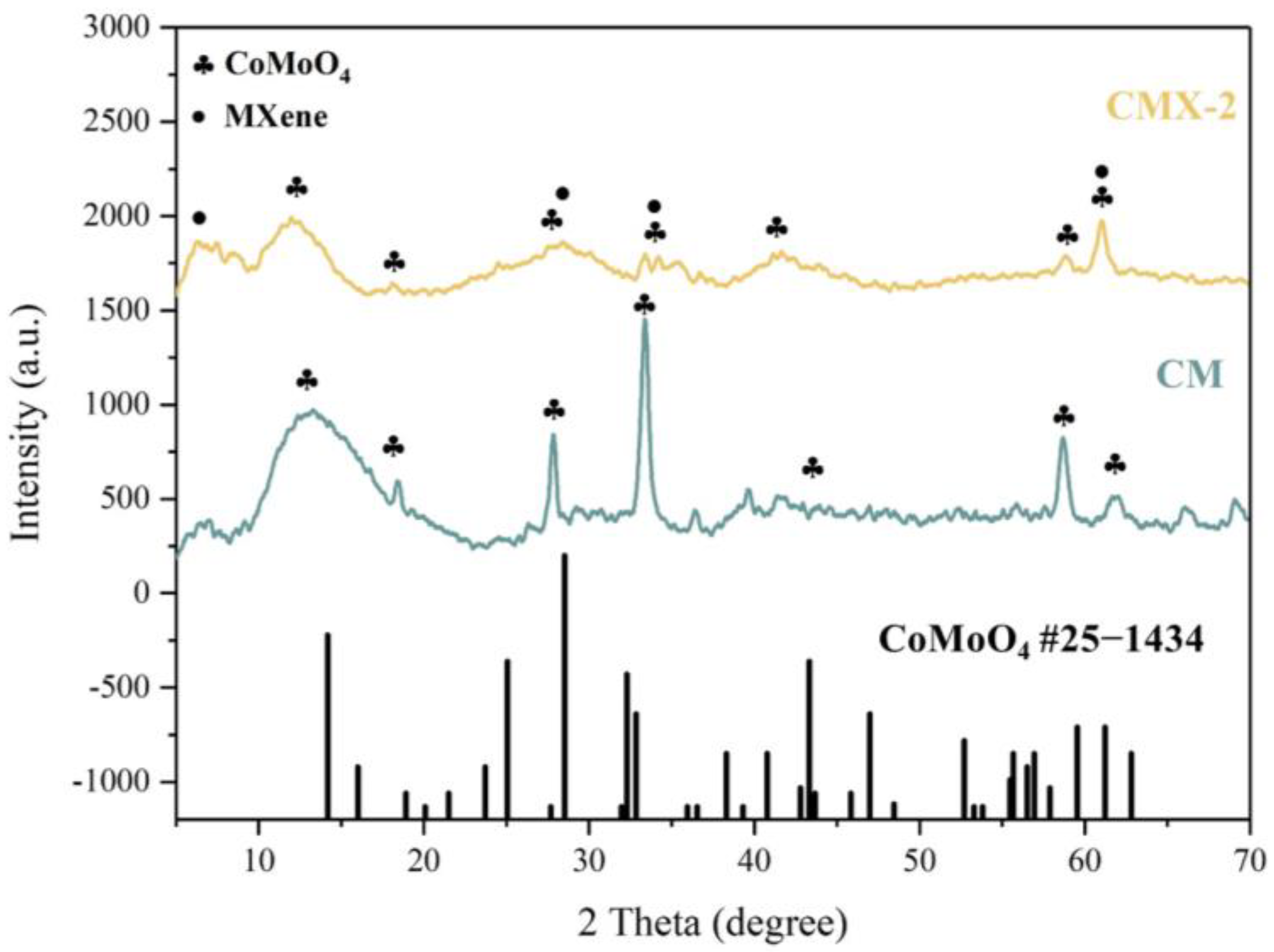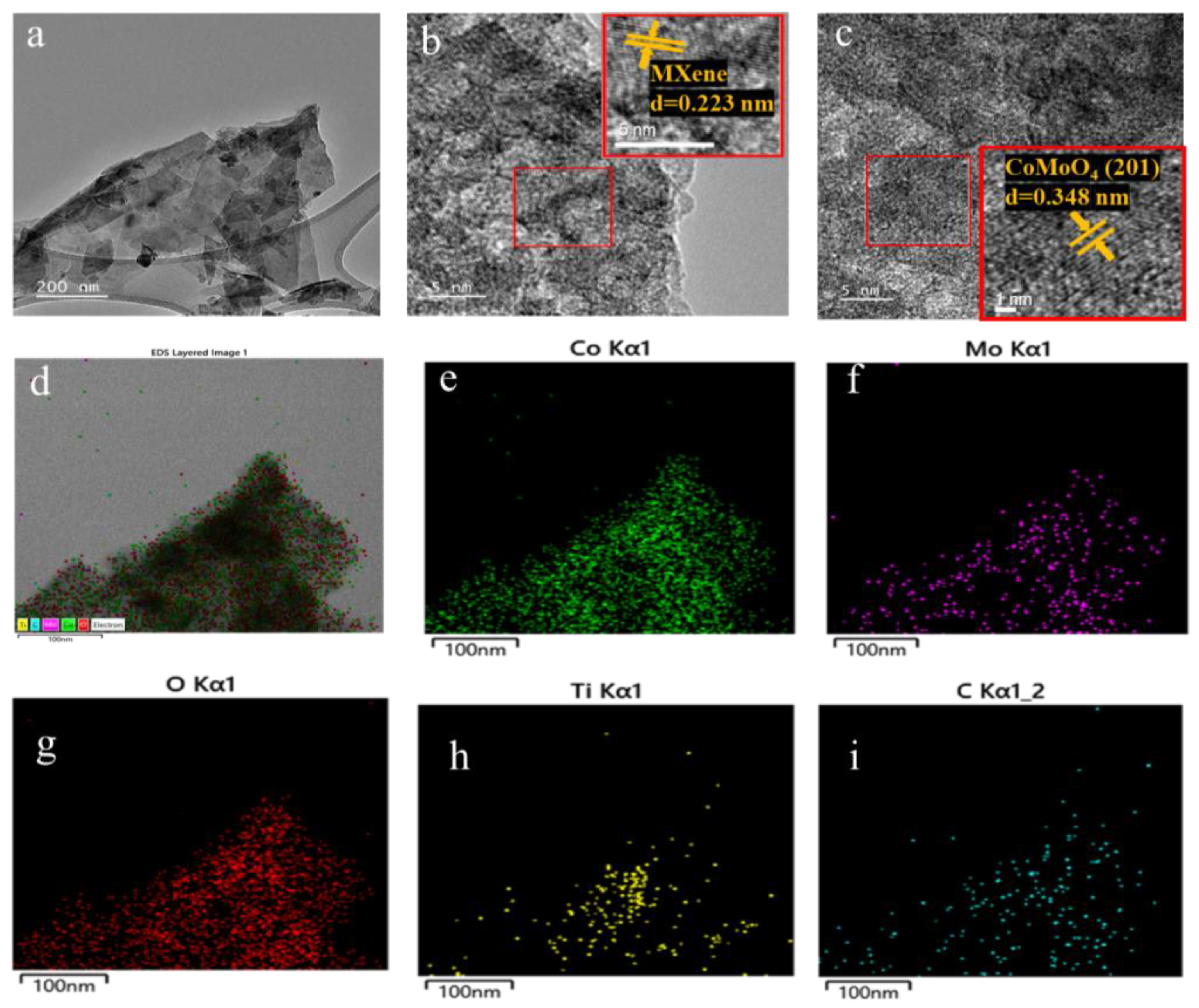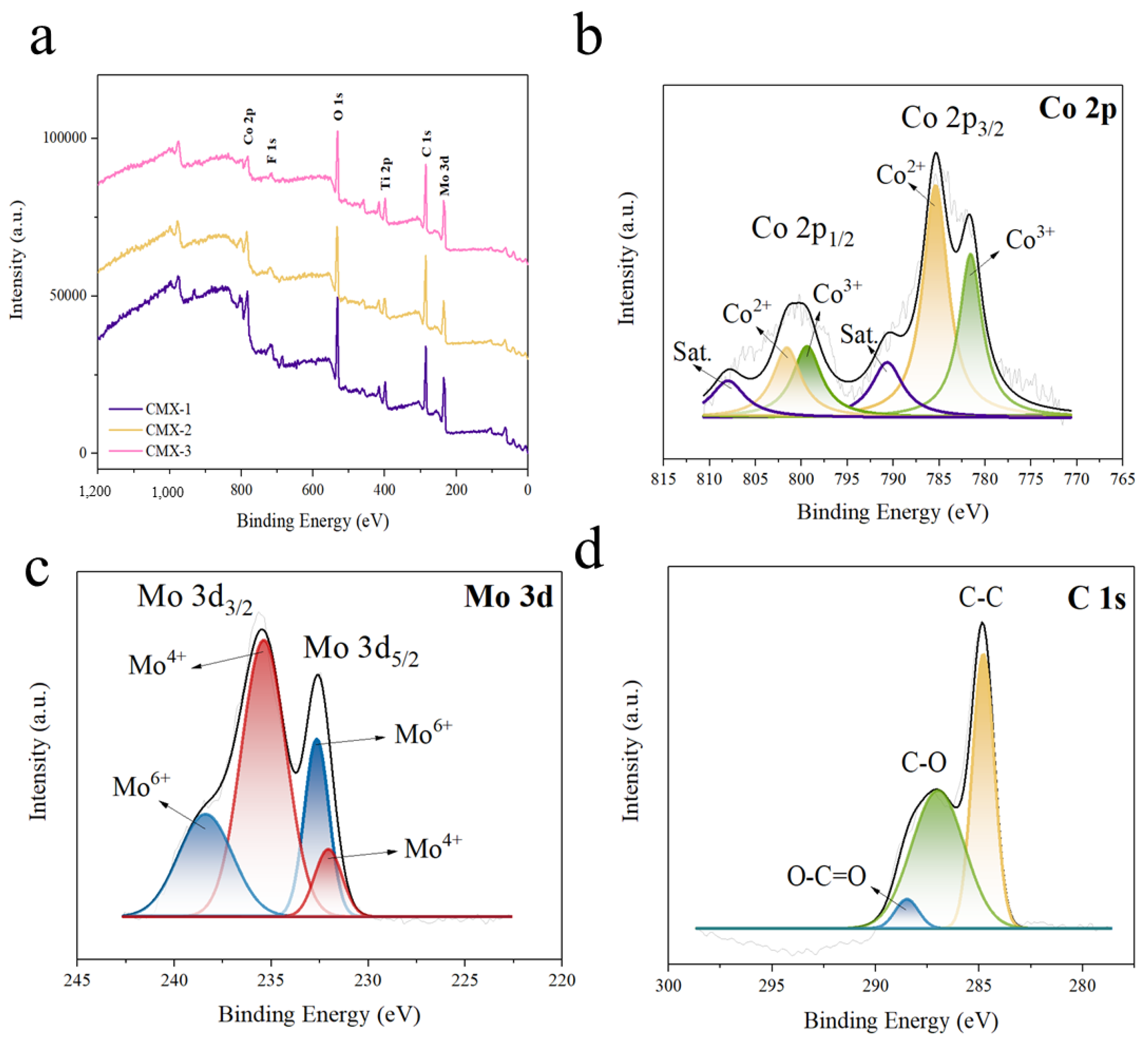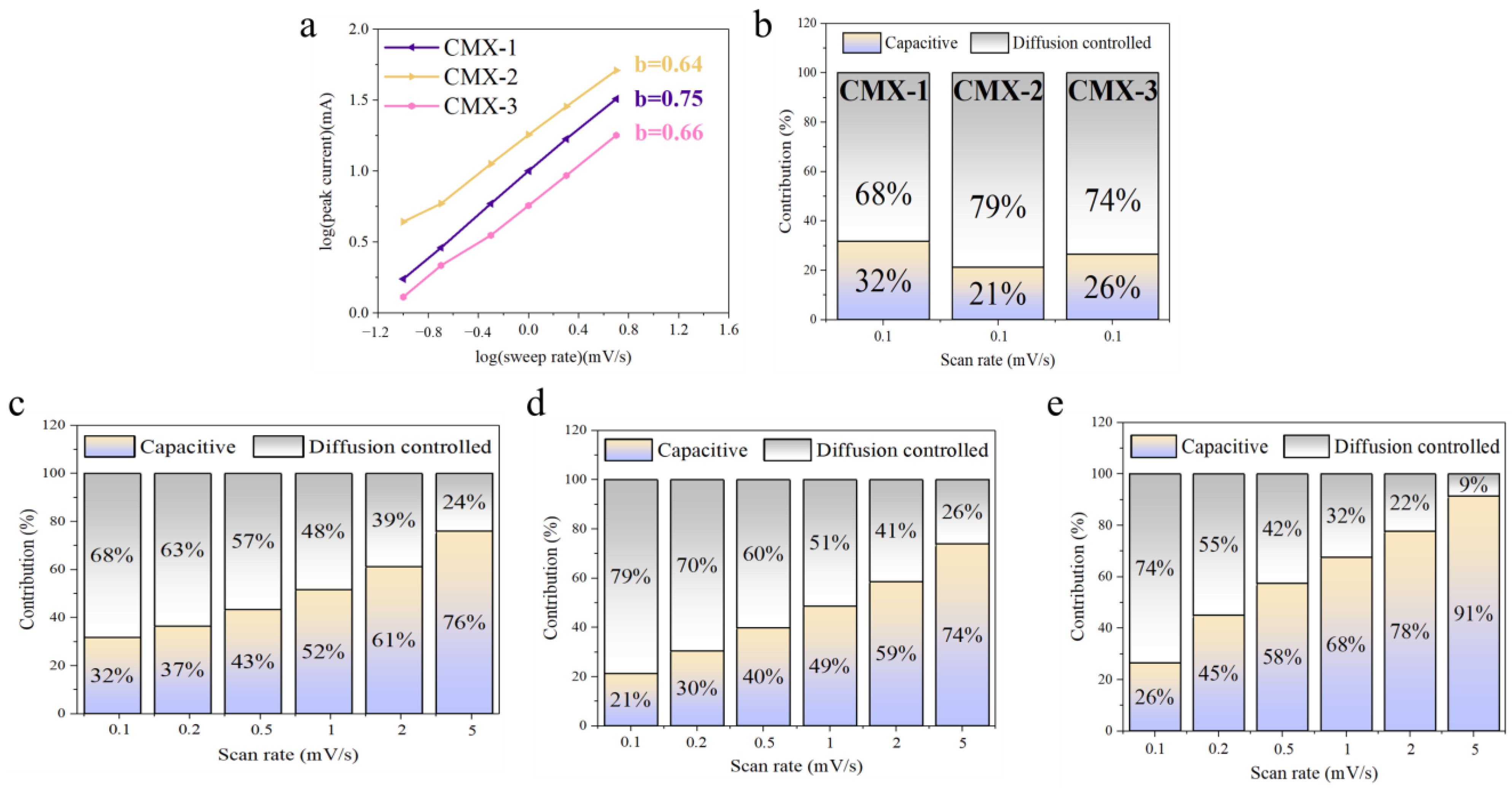1. Introduction
With the growing demand for energy storage solutions that are both efficient and sustainable, there is an increasing recognition of the critical significance of electrode materials. The selection of appropriate electrode materials stands as a pivotal factor within the realm of electrochemical energy storage, as these materials exert a direct and profound impact on crucial aspects like the energy density, power density, cycle life, and safety of energy storage devices. By optimizing electrode materials, it becomes possible to propel the performance and sustainability of electrochemical energy storage technologies to new heights.
Commonly used electrode materials encompass carbonaceous materials and a variety of metal oxides and hydroxides. Among these options, transition metal oxides have emerged as highly promising electrode materials for supercapacitors in recent years. Their appeal stems from their remarkable attributes, particularly their notably high theoretical specific capacitance. This enhanced specific capacitance is a consequence of the abundance of redox active sites inherent in these materials, facilitating efficient charge storage and transfer processes. Furthermore, the variable valence states of transition metal ions enable reversible redox reactions to take place at the interface between the electrode and electrolyte, thereby significantly augmenting the overall capacitance of the supercapacitor [
1,
2,
3,
4]. In contrast to single-component transition metal oxides, mixed transition metal oxides have gained prominence as compelling electrode materials for supercapacitors. This is primarily attributed to their capacity to provide increased electrical conductivity and a broader spectrum of redox reactions. The amalgamation of various transition metal elements within mixed oxides leads to enhancements in the electrical conductivity, thereby enabling a more efficient charge transfer within the electrode material [
5,
6,
7]. Additionally, the presence of multiple transition metals introduces diverse redox reactions. This allows for a greater variety of charge storage mechanisms to occur, and so, the overall capacitance performance of the supercapacitor can be enhanced. Thus, the exploration of mixed transition metal oxides presents a promising avenue through which the supercapacitor technology can be advanced. Recently, metal molybdates, such as CoMoO
4, NiMoO
4, and MnMoO
4, have demonstrated outstanding electrochemical performances over single component oxides [
8,
9,
10]. In particular, cobalt molybdate (CoMoO
4) has become highly attractive due to its structural properties and extraordinary capacitance [
7]. It is mainly composed of CoO
6 and MoO
4 [
11,
12]. CoMoO
4 can be prepared into various morphologies based on the synthetic condition. For example, Wang et al. fabricated CoMoO
4 nanoneeds grown on carbon cloth as a supercapacitor electrode, providing 2100 F g
−1 at a current density of 1 A g
−1 [
13]. Additionally, Yang et al. prepared a hybrid ZnCo
2O
4@CoMoO
4 heterostructure on Ni foam. It presented the specific capacitance of 1040 C g
−1 at 1 A g
−1 [
14]. Mei and colleagues effectively produced a nanostructured honeycomb Co–Mo oxide (CoMoO
x) using a self-assembly approach. The honeycomb-like structure exhibited remarkable structural durability, strong mechanical characteristics, and substantial pore accessibility, resulting in exceptional capabilities for lithium storage [
15]. Prasad et al. employed a hydrothermal method and incorporated ethanol into the process to synthesize pebble-like CoMoO
4 material [
16]. The pebble-like CoMoO
4 exhibited an excellent capacitance retention of 60.4% as the current density was elevated 1.5 to 10 A cm
−2. Even after undergoing 2000 cycles, the material retained a significant portion of its initial capacitance, specifically 85.95%.
Nevertheless, the utilization of metal oxide nanoparticles as electrode materials comes with a notable challenge: their propensity for agglomeration, which can ultimately diminish their performance. Agglomeration in this context refers to the tendency of metal oxide materials to coalesce into larger clusters or agglomerates during the manufacturing process and their subsequent use as electrodes in electrochemical energy storage devices. This phenomenon arises from various factors, including the elevated surface energy and strong interparticle interactions characterizing metal oxide nanoparticles.
The agglomeration of these nanoparticles introduces substantial hurdles to electrode performance and, by extension, the overall efficiency of the energy storage device. Primarily, agglomerates tend to exhibit reduced surface areas in comparison to individual nanoparticles, leading to a decrease in the number of accessible active sites for electrochemical reactions. This diminishment in the active surface area can have an adverse impact on the electrode’s specific capacity and its energy storage performance. Furthermore, the presence of agglomerates can create diffusion limitations within the electrode’s structure. The larger particle size and the presence of void spaces between these agglomerates impede the efficient transport of ions and electrons, consequently increasing the resistance and slowing down the reaction kinetics. As a result, the power density of the energy storage device may be compromised due to the sluggish charge/discharge rates [
17].
Mitigating the challenge of agglomeration in metal oxide materials represents a pivotal research focus within electrode design and fabrication. Diverse strategies are being employed to tackle this issue encompassing surface modifications of nanoparticles, the use of dispersing agents or binders to maintain particle dispersion, and the selection of appropriate solvent systems and processing techniques for controlling particle interactions. By effectively managing and minimizing agglomeration, researchers endeavor to enhance the electrochemical performance, stability, and reliability of electrodes based on metal oxides in the realm of electrochemical energy storage. One strategy to address the agglomeration issue involves the development of hybrid composites through the incorporation of two-dimensional materials renowned for their high conductivity. The primary objective of this integration is to achieve a significant enhancement in the electrochemical performance by capitalizing on the synergistic effects resulting from the distinct energy storage mechanisms exhibited by these materials.
Due to the abundant active sites and substantial surface areas, two-dimensional (2D) materials, such as graphene and zeolite nanosheets, have gained recognition as optimal substrates for catalytic applications [
18]. In recent years, a novel category of 2D layered materials, namely, MXenes, has captured significant scientific interest [
19]. MXenes are derived from the removal of A layers from M
n+1AX
n compounds. Here, M represents a transition metal, A stands for a IIIA or IVA group element, X denotes either C or N, and
n = 1, 2, 3, or 4. The postetching process yields MXenes, also denoted as Ti
3C
2T
x, with T
x signifying surface functional groups such as –OH and –F [
20,
21,
22]. Ti
3C
2T
x MXenes demonstrate an outstanding conductivity (2.0 × 10
4 S cm
−1), possess a two-dimensional structure, feature abundant surface functional groups, and have the capability to enhance electrochemical performance by expanding their interlayer spacing. The unique layered arrangement of Ti
3C
2T
x MXene provides ample room for anchoring functional nanomaterials, promoting better dispersion on the Ti
3C
2T
x MXene surface [
23,
24,
25]. This attribute underscores the potential effectiveness of Ti
3C
2T
x MXenes in addressing the challenge of nanomaterial agglomeration [
26]. For example, Tian et al. utilized a flexible and binder-free Si/MXene composite paper as the anode electrode material for lithium-ion batteries [
27]. The distinctive structure of this composite paper offers the increased volume expansion space for accommodating stress, and so, this composite paper provided a high capacity of 2118 mAh g
–1 at a 200 mA g
–1 current density after 100 cycles, maintaining a steady cycling ability of 1672 mAh g
–1 at 1000 mA g
–1 after 200 cycles. Su et al. synthesized ultradispersed binary Fe
3N/Co–N–C@MXene catalysts for zinc–air battery [
28]. Compared to Fe
3N/Co–N–C, these hybrid materials exhibited uniformly distributed active sites and an enhanced interaction with the electrolyte. The Fe
3N/Co–N–C@MXene-based zinc–air battery exhibited a higher peak power density (189.16 mW cm
−2) and stable cycle stability within 320 h.
Based on the aforementioned considerations, this study aimed to fabricate CoMoO4/Ti3C2Tx MXene heterogeneous materials. To that end, CoMoO4, commonly known for its high theoretical capacitance, was incorporated onto the interlayer and the surface of Ti3C2Tx MXene flakes using a hydrothermal method. Nanosized CoMoO4 particles of uniform size were synthesized by using urea as a particle size-controlling agent. The presence of Ti3C2Tx MXene mitigated excessive aggregation during the growth of metal oxides. The comparative analyses demonstrated that the CoMoO4/Ti3C2Tx MXene electrode could outperform the pure Ti3C2Tx MXene, single metal oxide/Ti3C2Tx MXene, and pure CoMoO4 electrodes in the performances of the supercapacitors.
5. Results and Discussion
The synthesis of the CMX samples was a straightforward yet effective hydrothermal process in which a meticulous calcination step was involved, as illustrated in
Figure 1. Initially, MAX was subjected to HF etching to eliminate the atomic aluminum layer, thereby yielding pristine Ti
3C
2T
x MXene. Subsequently, a hydrothermal reaction was orchestrated to foster the growth of Co and Mo precursor nanoparticles directly onto the Ti
3C
2T
x MXene substrate. Finally, the carefully controlled calcination process was employed to transform these precursors into the coveted CoMoO
4 phase. These meticulously executed steps resulted in the formation of CoMoO
4/Ti
3C
2T
x MXene composites with a sophisticated three-dimensional heterostructure.
In order to better obtain Ti
3C
2T
x MXene, MAX is usually required to undergo an etching process.
Figure S1a shows the MAX material. This material displays a typical layered structure in which the layers are tightly interconnected to form a dense morphology. When etched with 48 wt% HF, the resulting Ti
3C
2T
x MXene sample (
Figure 2a) exhibited evident layers of structures with a characteristic accordion-like morphology. This suggests a highly successful etching process for the production of MXene. The results generated from the analysis of the XRD crystal structure of MAX and Ti
3C
2T
x MXene are provided in
Figure S1b; the measurement was in the 2θ ranges of 5° to 70°. The MAX sample exhibited characteristic peaks of MAX materials at 2θ values of 9.4°, 19.1°, 33.9°, 36.7°, 38.7°, 41.6°, 48.4°, 56.2°, and 60.1°, corresponding to the (002), (004), (101), (103), (104), (105), (107), (108), and (110) crystal planes’ diffraction peaks [
29]. In the Ti
3C
2T
x MXene sample, at 2θ values of 8.8°, 18.5°, 27.8°, 34.1°, 41.7°, and 60.5°, peaks corresponding to the (002), (004), (006), (008), (0012), and (110) crystal planes were observed. This part of the finding is consistent with that which is documented in the referenced literature related to Ti
3C
2T
x MXene [
30]. Notably, the (104) crystal plane was absent in the Ti
3C
2T
x MXene sample, which indicates the removal of the aluminum layer. As shown in
Figure S1c, it can be observed that the (002) crystal plane peak of Ti
3C
2T
x MXene shifts leftward, from 2θ = 9.4° to 8.8°. This is because that the interlayer spacing has increased after the etching process. The Raman spectrum of Ti
3C
2T
x MXene can possibly exhibit multiple characteristic peaks in the range of 100–800 cm
−1 [
31]. A wavelength of 207 cm
−1 arises from the A
1g (Ti, C, and T
x) composition within the laminar regions. This wavelength is associated with the in-plane and out-of-plane vibrations of the outermost Ti atoms, as well as the vibrations of carbon and surface terminations [
32]. The spectral range spanning from 250 to 470 cm
−1 corresponds to in-plane (E
g) vibrations of surface terminations connected to Ti atoms. In the 580–730 cm
−1 range, the vibrations are primarily attributed to carbon-related vibrations. It is apparent that these vibrations are limited due to the expansion and stacking of interlayer spacing. The introduction of intercalants, which leads to an increase in the water content between layers, enhances out-of-plane vibrations. A larger interlayer spacing results in a shift of the A
1g (C) peak from approximately 712 to 722 cm
−1.
In order to obtain the CoMoO
4/Ti
3C
2T
x MXene heterostructure, different concentrations of urea were employed to regulate the crystal formation and growth of CoMoO
4. T This process yielded three distinct samples with varying urea ratios, designated as CMX-1, CMX-2, and CMX-3, as illustrated in
Figure 2b–d. It is important to note that urea is commonly used as a precipitating agent in the coprecipitation method due to its high solubility in water and its ability to control the rate of hydrolysis, leading to the production of ammonium and hydroxide ions through temperature control [
33]. Urea gradually generates hydroxyl groups, and so, this results in a slow precipitation process that facilitates the formation of uniformly dispersed particles, thereby reducing aggregation. Within these samples, CMX-1 featured substantial and uniform CoMoO
4 crystal particles distributed on the Ti
3C
2T
x MXene surface. CMX-2, which had the lowest urea ratio, exhibited consistently small-sized and evenly distributed CoMoO
4 particles that grew between the Ti
3C
2T
x MXene layers. In contrast, CMX-3, with the highest urea ratio, showed fewer CoMoO
4 particles, indicating the insufficient growth of CoMoO
4 nanoparticles. This observation underscores the fact that modifying the urea concentration does, in fact, influence the growth characteristics of CoMoO
4 crystals. In
Figure 3 and
Figure S3a, the XRD analysis of CMX-1, CMX-2, and CMX-3 exhibited distinct diffraction peaks at 2θ values of 14.1°, 18.9°, 28.5°, 32.3°, 43.3°, 59.5°, and 61.2°. These correspond to the crystal planes (110), (−201), (220), (−222), (−330), (−351), and (152) of CoMoO
4 (JCPDS #25-1434), respectively. Additionally, diffraction peaks corresponding to Ti
3C
2T
x MXene were also observed. TEM and HRTEM images of CMX-2 are presented in
Figure 4a–c, revealing the well-crystallized structure of these hybrid materials. The lattice spacings of 0.223 and 0.348 nm can be ascribed to (002) plane of Ti
3C
2T
x MXene and (−201) plane of CoMoO
4, respectively. Furthermore, the EDS elemental mapping results, as displayed in
Figure 4d–i, confirmed the presence of Co, Mo, O, C, and Ti elements in the CMX-2 hybrid materials.
For comparison, the Co- and Mo-based precursor undergoing the hydrothermal and calcination process was adopted to prepare CoMoO
4 without Ti
3C
2T
x MXene. As clearly shown in
Figure S2a, the CM sample showed a needle-like structure. To compare with the single element transition metal oxide on Ti
3C
2T
x MXene, Co- and Mo-based precursors were integrated with Ti
3C
2T
x MXene, respectively, which were denoted as CoX and MoX, as can be seen in
Figure S2b,c. The CoX sample exhibited noticeable particles. This suggests that the particle size of the synthesized Co
3O
4 could be larger than the interlayer spacing of Ti
3C
2T
x MXene. As a result, Co
3O
4 tends to struggle to effectively grow between the layers of Ti
3C
2T
x MXene, thereby leading to a significant dispersion of metal oxide particles on the exterior of the Ti
3C
2T
x MXene layers. In
Figure S2c, no apparent particle formations were observed. This indicates that only a small amount of MoO
3 could grow onto the Ti
3C
2T
x MXene. CoX and MoX revealed distinct diffraction peaks, corresponding to the crystal planes of CoMoO
4 (JCPDS #25-1434), Co
3O
4 (JCPDS #42-1467), and MoO
3 (JCPDS #05-0508), respectively. Among all the composites, the diffraction peaks of residual Ti
3C
2T
x MXene were observed. Therefore, the XRD results suggest that the CMX-1, CMX-2, CMX-3, CoX, and MoX composites could be successfully synthesized.
The technique of XPS analysis was executed to investigate the valence states of CMX-1, CMX-2, and CMX-3. The full XPS spectra are depicted in
Figure 5, illustrating the presence of Co, Mo, O, C, and Ti elements in all samples. The element component ratio can be found in
Table S1. Notably, all samples exhibited a substantial carbon content and included Ti elements, signifying the prominent existence of the Ti
3C
2T
x MXene material. Additionally, the aluminum content in all three samples was observed to be below 0.1 at%, indicating the successful removal of the aluminum layer from the MAX phase. The high-resolution XPS spectra of CMX-1, CMX-2, and CMX-3 are individually presented in
Figure 5,
Figures S4 and S5, respectively. In the Co 2p spectrum, the peaks were fitted into satellites and two spin–orbit doublets. The peaks at 785.1 eV and 801.5 eV were attributed to Co
2+, while those at 781.8 eV and 799.5 eV corresponded to Co
3+. This spectral analysis corroborates the presence of cobalt oxide [
34]. In the Mo 3d spectrum, the peaks were deconvoluted into satellites and two spin–orbit doublets, Mo 3d
3/2 and Mo 3d
5/2. The peaks at 232.2 and 235.5 eV were assigned to Mo
4+, while the peaks at 232.8 and 238.4 eV were ascribed to Mo
6+ [
35]. In the C 1s spectrum, the peaks at 284.8 eV, 287.1 eV, and 288.5 eV corresponded to C–C bonds, C–O bonds, and O–C=O bonds, respectively [
36]. The amalgamation of the XRD, TEM, and XPS results provides compelling evidence that the material consists of a combination of CoMoO
4 and Ti
3C
2T
x MXene.
The porous structures of Ti
3C
2T
x MXene and CMX-2 were investigated using nitrogen adsorption–desorption isotherms, as shown in
Figure S6. Ti
3C
2T
x MXene showed a specific surface area of 2.2 m
2 g
−1 and an average pore size of 0.097 nm, while CMX-2, in contrast, showed a much larger specific surface area of 38.9 m
2 g
−1 and an average pore size of 0.150 nm. This indicates that the introduction of CoMoO
4 between the Ti
3C
2T
x MXene layers could significantly enlarge the surface area, which may facilitate the transportation of ions in the electrolyte for electrochemical applications.
The electrochemical performances of CM, CoX, MoX, CMX-1, CMX-2, and CMX-3 were analyzed using a three-electrode system in a 6 M KOH aqueous electrolyte. The results from cyclic voltammetry (CV) and galvanostatic charge−discharge (GCD) measurement of CMX-2 and other samples are shown in
Figure 6,
Figures S7 and S8. The CV curves showed high redox peak currents and large enclosed areas which reveal typical pseudocapacitive characteristics. The optimal potential window was adjusted to 0−0.5 V. The specific capacitances of Ti
3C
2T
x MXene, CM, CoX, MoX, CMX-1, CMX-2, and CMX-3 at a scan rate of 5 mV s
−1 were calculated to be 1.7, 501, 76, 51, 475, 698, and 189 F g
−1, respectively.
Figure 6c shows the specific capacitances of all the samples at various scan rates of 5 to 100 mV s
−1, and the corresponding retentions for all the samples were 45.7, 11.0, 20.7, 26.3, 33.5, 29.4, and 40.9%, respectively, as presented in
Figure 6d. CMX-2 possessed the highest specific capacitance among the samples. Compared to CMX-1 and CMX-3, it had a well-defined layered structure. This structure can hinder the aggregation of crystals and so enhance the structural stability. In addition, the uniformity of CoMoO
4 nanoparticle growth on the Ti
3C
2T
x MXene layer rendered a sufficient Faradaic reaction, which may in turn facilitate the transportation and diffusion of electrolyte ions. Ti
3C
2T
x MXene had nearly no capacitance contribution at this range of operation voltage window (
Figure S7a,b). The CM sample had a relatively high specific capacitance owing to the needle-like morphology. However, it is evident that without the Ti
3C
2T
x MXene layered structure, it suffered from an aggregation problem. This led to the lowest capacitance retention (11.0%). Due to their integration with Ti
3C
2T
x MXene, CoX and MoX exhibited enhanced capacitance retentions compared to the CM sample. Nevertheless, their relatively low specific capacitances can be attributed to the insufficient occurrence of Faradaic reactions within a single-metal system [
37]. The EIS measurements were conducted to evaluate the impedance of CMX-1, CMX-2, and CMX-3. As shown in
Figure 6e, the Nyquist plots unveiled a notable semicircular feature in the high-frequency range, followed by a linear portion in the low-frequency region. Notably, in the case of CMX-1, the semicircle exhibited a larger diameter, and the straight line had a lower slope. This observation implies a relatively higher level of ionic diffusion resistance and charge transfer resistance. This phenomenon can be predominantly attributed to the aggregation of CoMoO
4 on the Ti
3C
2T
x MXene layer. It is evident that the performance of CMX-2 and CMX-3 is quite similar. Despite CMX-3 demonstrating comparable electrical conductivity, the absence of observable CoMoO
4 nanoparticles on the Ti
3C
2T
x MXene surface resulted in a poor capacitive performance. Comparing the impedances of the Ti
3C
2T
x MXene, CM, MoX, and CMX-2 samples (
Figure S9) makes it evident that Ti
3C
2T
x Mxene exhibited the highest electrical conductivity, followed by CMX-2, MoX, and CM. CM, lacking the addition of Ti
3C
2T
x Mxene, exhibited the poorest conductivity, which subsequently led to the lowest capacitive retention performance, as discussed earlier. CMX-2, benefiting from its binary metal composition, exhibited a better conductivity than MoX. Consequently, these results strongly underscore the advantages of the integrated structure of Ti
3C
2T
x MXene and CoMoO
4.
To investigate the electrochemical kinetics involved in charge storage for the CMX-1, CMX-2, and CMX-3 electrode materials, cyclic voltammetry (CV) measurements were conducted over a range of scan rates, spanning from 0.1 to 2 mV s
−1. This analysis aimed to delve into the intricate dynamics of charge storage mechanisms, which encompass both diffusion-controlled and surface-controlled kinetics. Typically, the electrode’s current exhibits a power law relationship between the current density and the scan rate, as represented by the following equation [
38]:
The
b-value is the slope of the plot of log
i vs. log
v [
39]. A
b-value of 0.5 is a common indicator of a diffusion-controlled process, while a
b-value of 1 indicates a capacitive-controlled process. As depicted at
Figure 7a, the
b-values CMX-1, CMX-2, and CMX-3 were 0.75, 0.64, and 0.66, respectively. Significantly, it is important to highlight that CMX-2 exhibits a
b-value that closely approximates 0.5, indicating a diffusion-controlled behavior that significantly contributes to facilitating rapid redox reaction kinetics and ion diffusion throughout the process. This suggests that CMX-2 could offer an enhanced performance due to its advantageous charge storage mechanism primarily driven by diffusion control. Moreover, the quantitative comparisons between high-speed and slow kinetic processes can be made using the two equations provided below [
40]:
The parameter “
i” represents the current at voltage V, while “
k1v”and “
k2v1/2” correspond to the capacitive and diffusion-controlled process. The
k1-value and
k2-value can be determined from the linear relationship of the
k1v and
k2v1/2.
Figure 7b–d and
Figures S10–S12 illustrate the percentages of capacitive and diffusion-controlled processes of CMX-1, CMX-2, and CMX-3. At a scan rate of 0.1 mV s
−1, CMX-1, CMX-2, and CMX-3 samples exhibited 68%, 79%, and 74% in diffusion-controlled processes. Notably, at all scan rates, the CMX-2 electrode showed a higher proportion of diffusion-controlled contribution compared to the other two electrodes. This could be attributed to the well-defined layered structure of MXene/CoMoO
4 and uniformly distributed nanoparticles of CoMoO
4 in CMX-2, which facilitates the easier permeation of OH
− ions. The diffusion-controlled capacitances of the CMX-2 electrode were found to be 79%, 70%, 60%, 51%, 41%, and 26% at scan rates of 0.1, 0.2, 0.4, 0.6, 0.8, and 1 mV s
−1, respectively. This suggests that at low scan rates, the diffusion process predominantly governs, while at higher rates, the surface capacitive process takes control due to a limited diffusion time. Moreover, the significant predominance of the diffusion-controlled contribution to the overall capacitance implies a relatively constrained rate capability for the CMX-2 electrode, consistent with the earlier electrochemical results. The cycling stabilities were conducted in the scan rate of 40 mV s
−1 for 1000 cycles. The decreases in capacitance are 83.4%, 82.8%, and 83.8% for the CMX-1, CMX2, and CMX-3 electrode. After the cycling test, the CMX-2 electrode material underwent SEM analysis. As depicted in
Figure S13a,b, the Ti
3C
2T
x MXene layer retained its characteristic layered structure. However, the CoMoO
4 particles exhibited a tendency to agglomerate into larger clusters. This aggregation is likely to result in accumulated stress, ultimately leading to degradation during the cyclic stability test. Therefore, enhancing the stability of the MXene/CoMoO
4 heterostructure as a supercapacitor device electrode in the future may hinge on achieving a more robust morphology for CoMoO
4 nanoparticles.
In summary, we have successfully integrated Ti3C2Tx MXene and CoMoO4, resulting in the formation of the CoMoO4/Ti3C2Tx MXene heterostructure with a distinctive three-dimensional layered morphology. The enhanced electrochemical performance of the CoMoO4/Ti3C2Tx MXene heterostructure (698 F g−1 at a scan rate of 5 mV s−1) can be attributed to several factors. First, Ti3C2Tx MXene plays a crucial role in mitigating aggregation, thereby facilitating the electrochemical reactions. Additionally, the anchoring of CoMoO4 nanoparticles onto Ti3C2Tx MXene leads to an increased surface area, providing abundant electrochemical active sites. The remarkable specific capacitance of CMX-2 can be attributed to the uniform distribution of CoMoO4 nanoparticles and the stable three-dimensional hollow structure it possesses. These findings underscore the importance of manipulating metal oxide nanoparticle morphologies within the Ti3C2Tx MXene structure. This becomes particularly significant in the context of advancing innovative electrode materials for high-performance supercapacitors. The successful integration of Ti3C2Tx MXene and CoMoO4 and the resulting improvements in the electrochemical performance hold promise for the development of next-generation energy storage devices.
